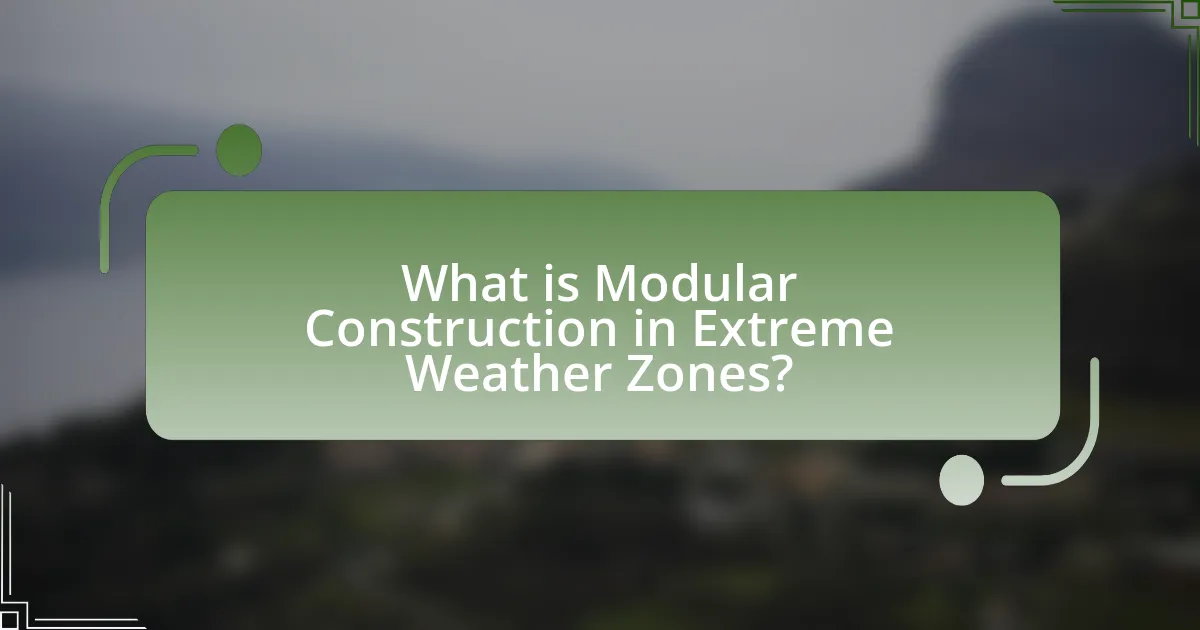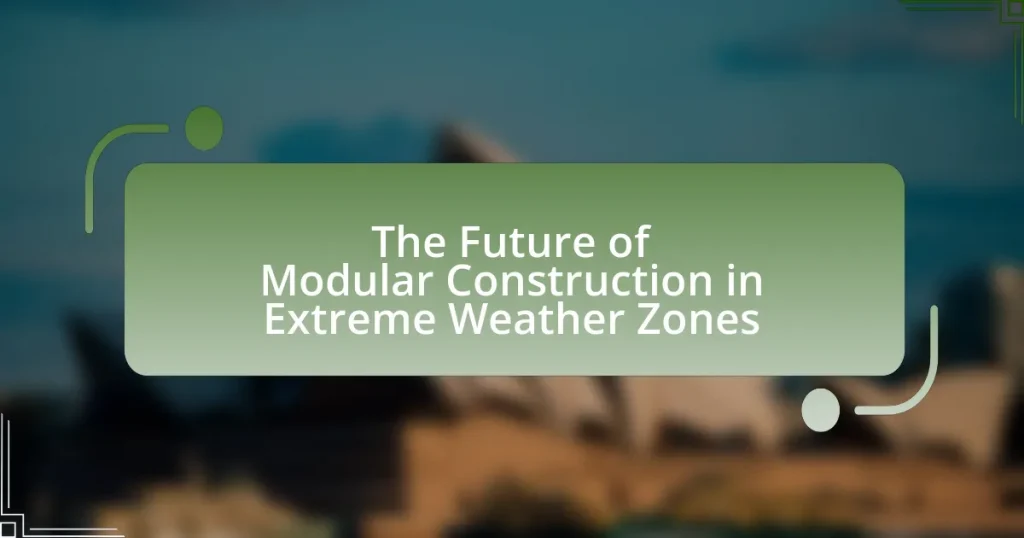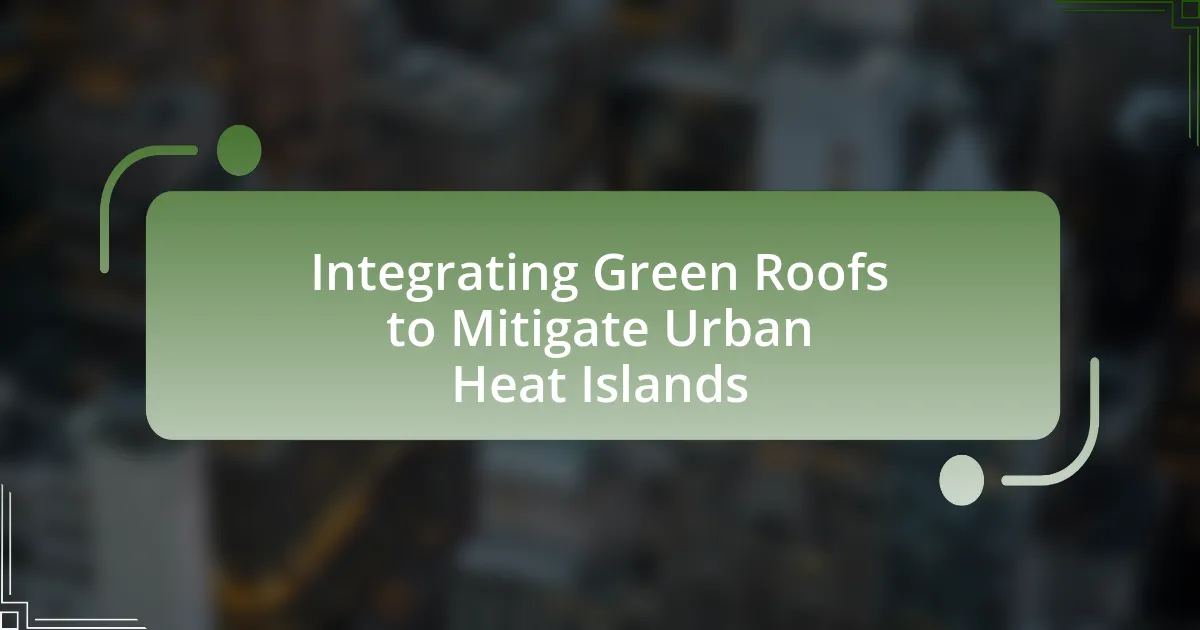Modular construction in extreme weather zones involves the use of prefabricated modules designed to withstand harsh environmental conditions, such as hurricanes and floods. This construction method offers advantages over traditional techniques, including faster assembly, reduced waste, and enhanced durability through advanced materials and engineering. Key features include prefabrication, cost efficiency, and design flexibility, making it particularly suitable for areas prone to extreme weather. The article explores the challenges faced by modular construction in these regions, innovations shaping its future, and best practices for ensuring safety and compliance, ultimately highlighting its economic implications and potential benefits for communities.

What is Modular Construction in Extreme Weather Zones?
Modular construction in extreme weather zones refers to the method of building structures using prefabricated modules designed to withstand harsh environmental conditions such as hurricanes, floods, or extreme temperatures. This construction approach utilizes advanced materials and engineering techniques to enhance durability and resilience, ensuring that buildings can endure severe weather events. For instance, research indicates that modular buildings can be engineered with reinforced materials and elevated designs to mitigate flood risks, as seen in projects like the modular housing developed in New Orleans post-Hurricane Katrina, which demonstrated improved safety and efficiency in construction timelines.
How does modular construction differ from traditional construction methods?
Modular construction differs from traditional construction methods primarily in its approach to building assembly, as it involves prefabricating sections of a structure in a factory setting before transporting them to the construction site for quick assembly. This method allows for faster construction timelines, often reducing project duration by 30-50% compared to traditional methods, which typically involve on-site construction from the ground up. Additionally, modular construction often results in less waste, with studies indicating a reduction of up to 90% in construction waste due to the controlled factory environment. This efficiency and sustainability make modular construction particularly advantageous in extreme weather zones, where rapid deployment and resilience are critical.
What are the key features of modular construction?
The key features of modular construction include prefabrication, speed of assembly, cost efficiency, and design flexibility. Prefabrication allows building components to be manufactured off-site in controlled environments, which enhances quality and reduces waste. The speed of assembly is significantly faster than traditional construction methods, often reducing project timelines by 30-50%. Cost efficiency arises from reduced labor costs and shorter construction durations, leading to lower overall project expenses. Design flexibility enables customization of modular units to meet specific needs and preferences, accommodating various architectural styles and functional requirements. These features collectively contribute to the growing adoption of modular construction, especially in response to the challenges posed by extreme weather conditions.
Why is modular construction suitable for extreme weather zones?
Modular construction is suitable for extreme weather zones because it allows for enhanced structural integrity and faster assembly, which are critical in such environments. The prefabrication process occurs in controlled settings, minimizing exposure to adverse weather conditions during construction. This method often employs advanced materials and techniques that improve resilience against high winds, heavy snow, and flooding. For instance, studies have shown that modular buildings can withstand wind speeds of up to 180 mph, making them ideal for hurricane-prone areas. Additionally, the rapid construction timeline reduces the duration of exposure to potential weather-related risks, further ensuring safety and durability.
What challenges does modular construction face in extreme weather zones?
Modular construction faces significant challenges in extreme weather zones, primarily due to structural integrity and material performance under harsh conditions. For instance, high winds can compromise the stability of modular units, necessitating enhanced anchoring systems and design modifications to withstand such forces. Additionally, extreme temperatures can affect the durability of materials used in modular construction; for example, certain plastics may become brittle in cold climates, while heat can warp components. Furthermore, the logistics of transporting modular units to remote or disaster-prone areas can be complicated by severe weather, leading to delays and increased costs. These challenges highlight the need for specialized engineering solutions and materials tailored to specific environmental conditions to ensure the viability of modular construction in these regions.
How do extreme weather conditions impact construction materials?
Extreme weather conditions significantly impact construction materials by affecting their durability, performance, and structural integrity. For instance, high temperatures can lead to thermal expansion in materials like concrete and steel, potentially causing cracking or warping. Conversely, extreme cold can result in brittleness in materials such as plastics and certain metals, increasing the risk of failure under stress. Additionally, heavy rainfall and flooding can compromise the integrity of materials like wood, leading to rot and mold growth. Research indicates that materials exposed to severe weather conditions may require enhanced specifications or treatments to maintain their performance, as evidenced by studies showing that buildings in hurricane-prone areas often utilize reinforced concrete and impact-resistant glass to withstand high winds and debris.
What are the logistical challenges of modular construction in these areas?
The logistical challenges of modular construction in extreme weather zones include transportation difficulties, site accessibility, and the need for specialized materials. Transportation of large modular units can be hindered by adverse weather conditions, such as heavy snow or flooding, which can delay delivery and increase costs. Site accessibility is often compromised in these areas, making it challenging to transport modules to the construction site. Additionally, extreme weather conditions may require the use of specialized materials that can withstand harsh environments, complicating procurement and increasing project timelines. These factors collectively impact the efficiency and feasibility of modular construction in such regions.
What innovations are shaping the future of modular construction in extreme weather zones?
Innovations such as advanced materials, climate-responsive design, and smart technology are shaping the future of modular construction in extreme weather zones. Advanced materials like insulated concrete forms and high-performance composites enhance structural integrity and energy efficiency, enabling buildings to withstand harsh conditions. Climate-responsive design incorporates features such as elevated foundations and aerodynamic shapes to reduce wind resistance and flooding risks. Additionally, smart technology, including IoT sensors and automated climate control systems, allows for real-time monitoring and adaptation to environmental changes, ensuring safety and comfort. These innovations collectively address the challenges posed by extreme weather, making modular construction more resilient and sustainable.
How is technology enhancing modular construction techniques?
Technology is enhancing modular construction techniques by integrating advanced digital tools such as Building Information Modeling (BIM), automation, and IoT (Internet of Things). These technologies streamline the design and manufacturing processes, allowing for precise planning and efficient resource management. For instance, BIM enables architects and engineers to create detailed 3D models that facilitate better collaboration and reduce errors during construction. Automation in manufacturing processes increases speed and consistency, while IoT devices monitor construction conditions in real-time, ensuring quality control and safety. According to a report by McKinsey & Company, the adoption of digital technologies in construction can improve productivity by up to 15%.
What role do sustainable practices play in future developments?
Sustainable practices are essential in future developments as they enhance resilience, reduce environmental impact, and promote resource efficiency. In the context of modular construction, these practices enable the use of eco-friendly materials and energy-efficient designs, which are crucial for adapting to extreme weather conditions. For instance, incorporating renewable energy sources and sustainable materials can decrease carbon footprints and improve the durability of structures. Research indicates that buildings designed with sustainability in mind can reduce energy consumption by up to 50%, demonstrating their significant role in shaping future developments in extreme weather zones.
How can modular construction be adapted for specific extreme weather conditions?
Modular construction can be adapted for specific extreme weather conditions by utilizing materials and design techniques that enhance durability and resilience. For instance, in hurricane-prone areas, modular units can be constructed with reinforced concrete and impact-resistant windows to withstand high winds and flying debris. In regions susceptible to heavy snowfall, roofs can be designed with steep pitches to prevent snow accumulation, while insulation materials can be optimized for thermal performance to combat extreme cold. Additionally, modular buildings can incorporate elevated foundations in flood-prone areas to mitigate water damage. These adaptations are supported by industry practices and research, such as the National Institute of Standards and Technology’s guidelines on resilient building design, which emphasize the importance of material selection and structural integrity in extreme weather scenarios.
What design considerations are necessary for hurricane-prone areas?
Design considerations for hurricane-prone areas include elevated structures, aerodynamic shapes, reinforced materials, and secure anchoring systems. Elevated structures help prevent flooding, as seen in coastal regions where homes are built on pilings or elevated platforms. Aerodynamic shapes reduce wind resistance, minimizing damage during high winds, which is crucial given that hurricanes can produce winds exceeding 150 mph. Reinforced materials, such as impact-resistant windows and concrete walls, enhance structural integrity against debris and wind forces. Secure anchoring systems, including tie-downs and straps, ensure that buildings remain anchored to their foundations, reducing the risk of uplift and displacement during severe storms. These considerations are essential for ensuring safety and resilience in the face of hurricanes.
How can modular buildings be engineered for earthquake resilience?
Modular buildings can be engineered for earthquake resilience by incorporating flexible structural designs, using advanced materials, and implementing base isolation systems. Flexible designs allow the building to absorb and dissipate seismic energy, reducing the risk of structural failure. Advanced materials, such as high-strength steel and reinforced concrete, enhance the building’s ability to withstand seismic forces. Base isolation systems, which decouple the building from ground motion, further protect the structure during an earthquake. Research indicates that buildings designed with these features can significantly reduce damage during seismic events, as demonstrated by the performance of modular structures in earthquake-prone regions like Japan and California.
What are the economic implications of modular construction in extreme weather zones?
Modular construction in extreme weather zones can lead to significant economic benefits, including reduced construction costs and shorter project timelines. The prefabrication process allows for components to be built in controlled environments, minimizing delays caused by adverse weather conditions. According to a study by McKinsey & Company, modular construction can reduce project delivery times by up to 50% and costs by 20% compared to traditional methods. Additionally, the resilience of modular buildings to extreme weather can lower long-term maintenance and repair costs, further enhancing their economic viability.
How does modular construction affect project timelines and costs?
Modular construction significantly reduces project timelines and costs by enabling parallel construction processes and minimizing on-site labor. This method allows for components to be fabricated off-site while site preparation occurs simultaneously, leading to a reduction in overall project duration by up to 30% compared to traditional construction methods. Additionally, modular construction can lower costs by approximately 10-20% due to reduced labor expenses and shorter project timelines, as evidenced by a study from McKinsey & Company, which highlights that modular projects often experience fewer delays and lower material waste.
What are the potential savings for communities in extreme weather zones?
Communities in extreme weather zones can achieve significant savings through modular construction, which can reduce building costs by 20% to 30% compared to traditional methods. This cost efficiency arises from the streamlined manufacturing process, reduced labor costs, and shorter construction timelines associated with modular buildings. For instance, a study by the National Institute of Standards and Technology found that modular construction can lead to a 50% reduction in construction time, which translates to lower financing costs and quicker occupancy. Additionally, modular buildings are often designed with enhanced resilience to extreme weather, potentially lowering insurance premiums and maintenance costs over time.
What best practices should be followed for successful modular construction in extreme weather zones?
Successful modular construction in extreme weather zones requires the implementation of specific best practices, including robust design, material selection, and site preparation. Robust design involves creating structures that can withstand high winds, heavy snow loads, or extreme heat, which is essential for durability and safety. Material selection should prioritize weather-resistant and energy-efficient materials, such as insulated panels and corrosion-resistant metals, to enhance the building’s resilience against harsh conditions. Site preparation must include proper drainage systems and foundation designs that account for potential flooding or soil instability, ensuring the structure remains stable and secure. These practices are supported by industry standards and guidelines, such as those from the International Code Council, which emphasize the importance of adapting construction methods to local environmental challenges.
How can stakeholders ensure compliance with safety regulations?
Stakeholders can ensure compliance with safety regulations by implementing rigorous safety management systems and conducting regular audits. These systems should include comprehensive training programs for employees, adherence to local and national safety standards, and the use of safety checklists during construction processes. For instance, the Occupational Safety and Health Administration (OSHA) provides guidelines that stakeholders can follow to maintain compliance, which includes regular inspections and reporting of safety incidents. By actively engaging in these practices, stakeholders can significantly reduce the risk of accidents and ensure that safety regulations are met consistently.
What strategies can be implemented to enhance community engagement?
To enhance community engagement, strategies such as fostering collaboration through local partnerships, utilizing social media for outreach, and organizing community events can be implemented. Collaboration with local organizations and stakeholders encourages shared ownership of projects, which increases community investment. Social media platforms serve as effective tools for disseminating information and gathering feedback, allowing for real-time interaction and engagement. Organizing community events, such as workshops or informational sessions, provides opportunities for residents to voice their concerns and contribute ideas, thereby strengthening community ties and involvement. These strategies have been shown to improve participation rates and foster a sense of belonging among community members.



